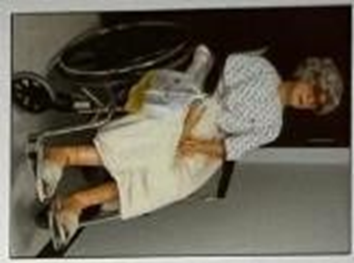The nurse enters the room of an older adult client and observes the client positioned in a wheelchair as seen in the picture. The unlicensed assistive personnel (UAP) is preparing to push the client's wheelchair in the hallway. Which instruction should the nurse provide the UAP before the client is moved into the hallway?

Use a belt restraint to secure the client in the chair.
Empty the client's urinary drainage bag.
Reposition the client's urinary drainage bag.
Elevate the client's feet higher on the foot rests.
The Correct Answer is C
A. Using a belt restraint is generally not recommended unless specifically ordered for safety reasons, as it may not be appropriate or necessary in all cases. Restraints should only be used when absolutely needed and when all other methods of ensuring safety have been considered.
B. Emptying the urinary drainage bag before moving the client is important to prevent overflows and ensure that the bag does not become a source of discomfort or potential infection. However, this step might not always be immediately necessary unless the bag is full or the client’s comfort and hygiene are at risk.
C. Repositioning the urinary drainage bag is crucial for ensuring that the bag remains below the level of the bladder and is not subject to kinks or obstructions. This helps prevent backflow and potential infections. Proper positioning also contributes to the client’s comfort and dignity, making this a priority before moving the client.
D. Elevating the client’s feet on the footrests is important for their comfort and to prevent swelling or pressure sores, especially if the client has limited mobility or circulatory issues. Proper positioning can prevent discomfort and promote better circulation, which is essential for maintaining the client’s well- being during transport.
Nursing Test Bank
Naxlex Comprehensive Predictor Exams
Related Questions
Correct Answer is B
Explanation
A. A serum hemoglobin level of 16 g/dL (160 g/L) is within the normal reference range for adults (14 to 18 g/dL). Hemoglobin levels that are within the normal range generally do not indicate a direct risk for falls. Low hemoglobin (anemia) could potentially increase fall risk due to fatigue or dizziness, but a normal level is not a risk factor for falls.
B. Opioid analgesics are known to have side effects such as sedation, dizziness, and impaired motor coordination, which can increase the risk of falls. The recent administration of opioids makes this a significant factor in assessing fall risk, as the client may still be experiencing side effects from the medication that could impair their balance or cognitive function.
C. Depression can contribute to fall risk in several ways, including reduced motivation to engage in activities, decreased physical strength, and impaired attention. However, while important to address, depression alone is not as immediate or direct a risk factor for falls compared to factors like recent medication side effects or actual physical impairments.
D. Stooped posture may be indicative of issues such as musculoskeletal problems or balance difficulties. However, if the client has a steady gait, it suggests that despite the stooped posture, their current ability to walk is stable. The stooped posture alone might increase fall risk over time, but it is not as directly related to the immediate risk of falls as recent medication effects.
Correct Answer is C
Explanation
A. This description is more characteristic of a Stage 3 or Stage 4 pressure injury. Stage 3 pressure injuries involve full-thickness skin loss and may expose subcutaneous tissue, and Stage 4 involves extensive damage with possible exposure of muscle, bone, or tendon. Sloughing (a type of necrotic tissue) is not typical of Stage 2 pressure injuries.
B. This description is more indicative of a Stage 1 pressure injury. Stage 1 injuries are characterized by non-blanchable erythema of intact skin, and pain or discomfort in the affected area is common. Stage 1 does not involve the loss of skin integrity, so it would not be the appearance of a Stage 2 injury.
C. This description accurately matches the appearance of a Stage 2 pressure injury. Stage 2 pressure injuries are characterized by partial-thickness loss of skin, which may present as a shallow open ulcer with a red or pink wound bed. It does not extend through the entire thickness of the skin.
D. This description aligns with Stage 3 or Stage 4 pressure injuries, which involve full-thickness skin loss with possible necrotic tissue and deep pockets of infection. These stages involve significant tissue damage beyond what is seen in Stage 2 injuries.
Whether you are a student looking to ace your exams or a practicing nurse seeking to enhance your expertise , our nursing education contents will empower you with the confidence and competence to make a difference in the lives of patients and become a respected leader in the healthcare field.
Visit Naxlex, invest in your future and unlock endless possibilities with our unparalleled nursing education contents today
Report Wrong Answer on the Current Question
Do you disagree with the answer? If yes, what is your expected answer? Explain.
Kindly be descriptive with the issue you are facing.
